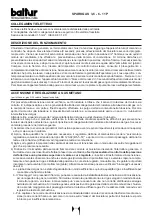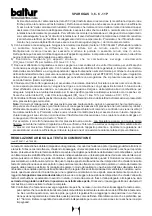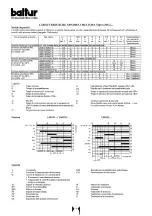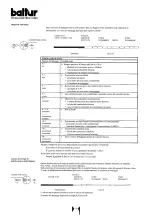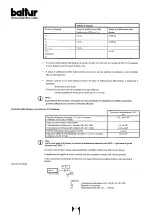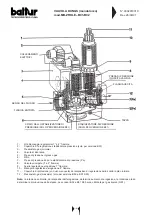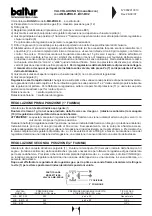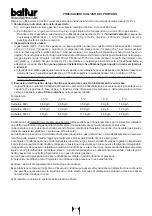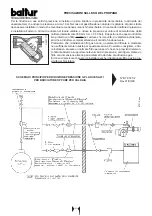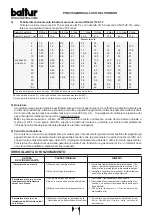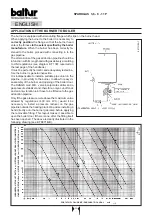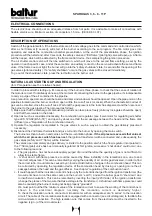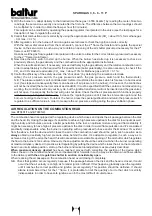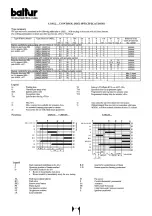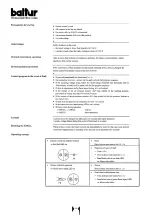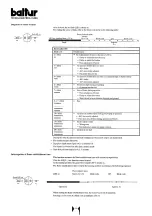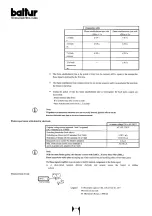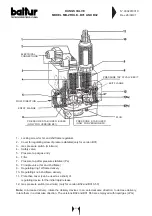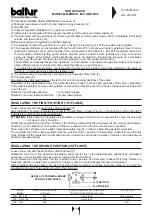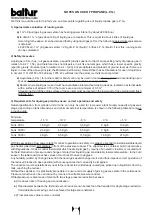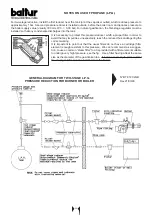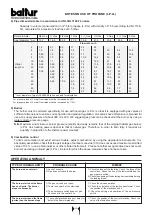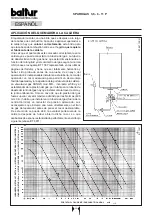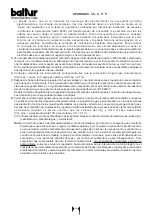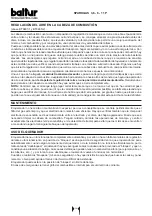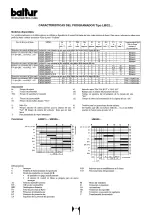
25
5) With the burner on, adapt delivery to that desired (methane gas = 8550 Kcal/m
3
) by reading the meter. Take two
readings, the second one exactly one minute after the first one. The difference between the two readings schould
be multiplied by in order to obtain the flow per hour (60 minutes).
This output can be modified by operating the special regulator incorporated in the valve (see the last pages for a
desciption of how to regulate the valves).
6) Control that combustion occurs correctly by using the appropriate instruments (CO
2
= about 10% for methane gas
- CO max. = 0.1%).
7) After regulation, turn the burner off and on again several times to check that ignition occurs correctly.
With the burner disconnected from the main switch, connect the 2
nd
flame thermostat and regulate the special
device on the servomotor in such a way as to obtain an opening of the air shutter presumed necessary for the 2
nd
flame (see BT 8920/1).
Open as well the gas flow regulator incorporated in the valve to allow for the correct delivery presumed necessary
for the 2
nd
flame (main flame).
8) Now close the main switch to start up the burner. When the burner has started up it is necessary to check, as
previously shown, the gas delivery and the combustion with the appropriate instruments.
When the results are known, if necessary, proceed with varying the gas delivery and the relative combustion air in
order to adapt delivery to that required for the specific case (boiler potentiality). It is also necessary to check if the
CO
2
and CO values are adequate (CO
2
max. = about 10% for Methane gas and CO = 0.1%).
9) Control the efficiency of the safety devices: the “shut down” (by detaching the ionisation electrode
cable), the air pressure switch, the gas pressure switch, the gas pressure switch and the thermostats).
N.B. The pressure switch is self-controlled and trefore it must close the contact, which is foreseen to be closed at
rest, (fan stops and consequently there is an absence of air pressure in the burner); if it does not, the control box
will not be inserted (the burner remains at as standstill). It must be specified that if the contact is not closed during
working, the control box will carry out its cycle, but the ignition transformer will not be inserted and the gas valves
will not open. Consequently, the burner will go to shut down. Check that the air pressure switch functions properly
with burner operating at 1
st
flame only, increase the regulating value until it reaches intervention point and the
burner should go to shut down. To ublock the burner, press the special pushbutton and return the pressure switch
regulator to a sufficient value in order to measure the air pressure existing during the pre-ventilation phase.
AIR REGULATION ON THE COMBUSTION HEAD
(see BT9481/1 and BT9485/2)
The combustion head is equipped with a regulating device which closes and opens the air passage between the disk
and the head. By closing the passage it’s possible to achieve high pressure upstream the disk for low inputs as well.
High velocity and turbulence ensure a better penetration in the fuel, an optimum mixture and good flame stability. It
might be necessary to have high air pressure upstream the disk in order to avoid flame pulsation and it’s considered
practically indispensable when the burner is operating with a pressurised furnace and/or thermal load. It’s evident
from the above, that the device which closes the air on the combustion head should be put in such a position as to
always obtain a decidedly high air pressure value behind the disk. It’s advisable to regulate in such a way as to
achieve a closing of the air on the head; this will necessitate a considerable opening of the air shutter which regulates
the flow to the burner’s fan suction. Obviously, these adjustments should be carried out when the burner is operating
at maximum delivery desired. In practice, start regulating by putting the device which closes the air on the combustion
head in an intermediate position, start up the burner and make trial adjustments as previously described.
When maximum delivery desired has been reached, proceed with correcting the position of the device which
closes the air on the combustion head; move it backwards or forwards in such a way as to obtain an air flow suitable
to the delivery, with the air regulation shutter in suction considerably open.
When reducing the air passage on the combustion head, avoid closing it completely.
N.B. Check that ignition occurs regularly, because if the passage between the disk and the head is closed, it could
occur that the air velocity is so high as to render ignition difficult. If this happens, gradually open the regulator
until it reaches the correct position and ignition occurs regularly. This position should be definitive. It should
alsobe remembered that, for the 1
st
flame, it is preferable to limit the quantity of air to that which is strictly
indispensable in order to have safe ignition even in the most difficult circumstances.
SPARKGAS 3,6 - 6 - 11 P
Содержание SPARKGAS 3,6
Страница 14: ...14...
Страница 15: ...15...
Страница 16: ...16...
Страница 17: ...17...
Страница 27: ...27...
Страница 28: ...28...
Страница 29: ...29...
Страница 30: ...30...
Страница 40: ...40...
Страница 41: ...41...
Страница 42: ...42...
Страница 43: ...43...
Страница 53: ...53...
Страница 54: ...54...
Страница 55: ...55...
Страница 56: ...56...
Страница 66: ...66...
Страница 67: ...67...
Страница 68: ...68...
Страница 69: ...69...

